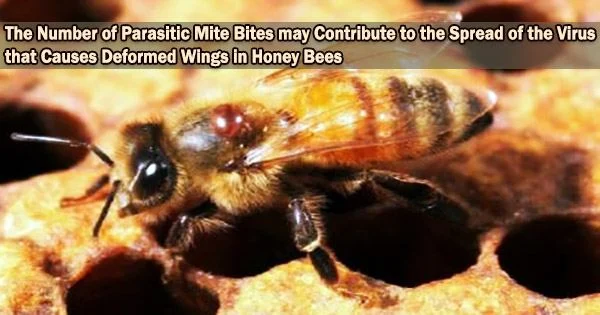Deformed Wing Virus (DWV) is a common virus in honey bees that affects their wings and reduces their lifespan. The transmission of DWV in honey bee colonies has been linked to the biting rate of parasitic mites, such as Varroa mites, which feed on the hemolymph (the “blood”) of bees and can introduce the virus into the colony. High mite infestations increase the virus transmission rate, leading to the spread of DWV among the bees in the colony.
Ectoparasitic mite Varroa destructor can bring down European honey bee colonies by dispersing the Deformed Wing Virus while it feeds. A relatively small number of mites may be responsible for a high number of sick bees, according to a study by Zachary Lamas and colleagues from the USDA-ARS and the University of Maryland that was published in PLOS Pathogens.
Arthropod disease vectors transmit pathogens while feeding on susceptible hosts. However, little is known about how adult honey bees get infected by viruses as a result of the eating habits of Varroa. A number of tests were carried out by researchers to better understand the parasitism of honey bees by the Varroa mite.
Our work shows that viral spread is driven by Varroa actively switching from one adult bee to another as they feed. Relatively few of the most active Varroa parasitize the majority of bees. The ability to parasitize and infect multiple adult bees provides the best explanation to date for the maintenance and subsequent host-to-host spread of viruses among the long-lived worker bees common in these crowded and vulnerable colony populations.
When adult bees entered a known feeding spot, they first used fluorescent microspheres to check if Varroa were feasting on them. They next allowed Varroa to feed on bee pupae that had been injected with fluorescent microspheres in order to ascertain whether microspheres could be passed from a Varroa to an adult bee via Varroa eating.
In the third experiment, researchers observed mites switching from adult bee host to host. The researchers next evaluated the percentage probability of Varroa parasitism in adult workers after observing how a single mite could spread diseases by feeding on numerous bees.
The majority of adult honey bee deaths were caused by mites with high virus counts and frequent switchers. Varroa are promiscuous feeders and switch hosts at a high rate.
Nearly three times as many hosts were parasitized by mites that switched hosts often as opposed to those that switched less frequently. Future research is required to comprehend the mechanisms that cause mites to transfer hosts.
According to the authors, “Our work shows that viral spread is driven by Varroa actively switching from one adult bee to another as they feed. Relatively few of the most active Varroa parasitize the majority of bees. The ability to parasitize and infect multiple adult bees provides the best explanation to date for the maintenance and subsequent host-to-host spread of viruses among the long-lived worker bees common in these crowded and vulnerable colony populations.”
















